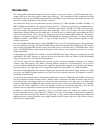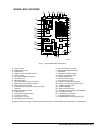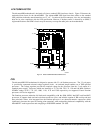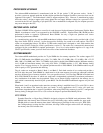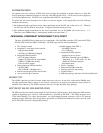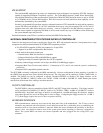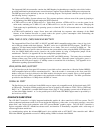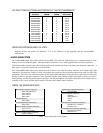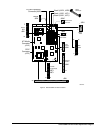
Advanced/RH Technical Product Specification •• Page 12
The integrated 8042 microcontroller contains the AMI Megakey keyboard/mouse controller code which, besides
providing traditional keyboard and mouse control functions, supports Power-On/Reset (POR) password protection.
The POR password can be defined by the user via the Setup program. The keyboard controller also provides for
the following "hot key" sequences:
• <CTRL><ALT><DEL>: System software reset. This sequence performs a software reset of the system by jumping to
the beginning of the BIOS code and running the POST operation.
• <CTRL><ALT><+> and <CTRL><ALT><->: Turbo mode selection. <CTRL><ALT><-> sets the system for de-
turbo mode, emulating an 25 MHz AT, and <CTRL><ALT><+> sets the system for turbo mode. Changing the
Turbo mode may be prohibited by an operating system, or when the CPU is in Protected mode or virtual x86 mode
under DOS.
• <CTRL><ALT><defined in setup>: Power down and coffee-break key sequences take advantage of the SMM
features of the Pentium Processor to greatly reduce the system’s power consumption while maintaining the
responsiveness necessary to service external interrupts.
REAL TIME CLOCK, CMOS RAM AND BATTERY
The integrated Real Time Clock (RTC) is DS1287 and MC146818 compatible and provides a time of day clock
and a 100-year calendar with alarm features. The RTC can be set via the BIOS SETUP program. The RTC also
supports a 242-byte battery-backed CMOS RAM area in two banks. This area is reserved for BIOS use. The
CMOS RAM can be set to specific values or cleared to the system default values using the BIOS SETUP program.
Also, the CMOS RAM values can be cleared to the system defaults by using a configuration jumper on the
motherboard. Table B-1, in Appendix B, lists the configuration jumper settings.
An external coin-cell style battery provides power to the RTC and CMOS memory. The battery has an estimated
lifetime of three years if the system is not plugged into the wall socket. When the system is plugged in, power is
supplied from the LPX power supply’s 5v standby current to extend the life of the battery. See Appendix A for
information regarding replacement batteries.
IRDA (INFRA-RED) SUPPORT
A 5-pin interface on the front panel I/O connector is provided to allow connection to a Hewlett Packard HSDSL-
1000 compatible Infra-red (IrDA) transmitter/receiver. Once the module is connected to the front panel I/O
header, serial port 2 can be re-directed to the IrDA module, allowing the user to transfer files to or from portable
devices such as laptops, PDA’s and printers using application software such as LapLink. The IrDA specification
provides for data transfers at 115 Kbps from a distance of 1 meter.
PARALLEL PORT
The Parallel port can be configured in the BIOS setup as output only compatible mode, bi-directional mode, ECP
or EPP modes. The highly flexible parallel port can also be assigned to I/O addresses 278H, 378H, or 3BCH and
IRQ’s 5 or 7. Furthermore, a routable DMA scheme allows Plug ‘N’ Play operating systems such as Windows 95
to route either DMA channel 1 or 3 to the parallel port for ECP mode. EPP BIOS support must be provided by a
device driver or TSR.
GRAPHICS SUBSYSTEM
The ATI-264VT controller is a highly integrated multimedia graphics & video controller for PCI bus systems. The VT
achieves enhanced performance with an all in one design that integrates a video scaler, a color space converter, a true color
palette DAC, and a triple clock synthesizer with ATI’s proven Mach64
†
graphics engine. The ATI-264VT controller is
register compatible with ATI’s Mach64 accelerator series, and therefore is immediately compatible with a wide range of
software applications and drivers.
As a manufacturing option, the Advanced/RH board is also available with an ATI-264CT video controller and 1 MB of
EDO video DRAM, upgradeable to a total of 2 MB by adding 1 MB of socketed video DRAM.




